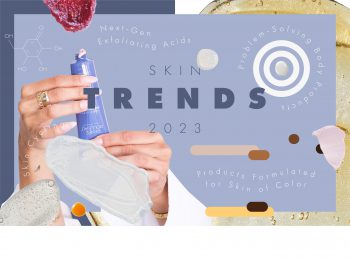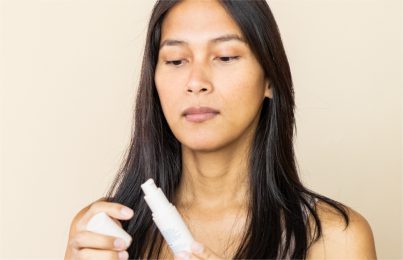Updated 1/12/25. To date, the introduction of acids used topically on the skin has been one of the biggest advancements in skin care. After all, they were introduced back in the late 80s but after all these years, alpha hydroxy acids (AHAs) and beta hydroxy acids (BHAs) and now polyhydroxy acids (PHAs) are more popular than ever. That’s a true sign that these ingredients really do yield positive results in the ever-changing skincare industry.
I remember when I first got my hands on an acid formula when I first became an esthetician. I was so excited to use it and it ended up totally burning my skin raw. They were so highly unstable and you had to be really careful when using it — which clearly I wasn’t. Today’s formulas for home-use are so safe, so no worries there.
What benefits do exfoliating acids offer?
- Skin appears smoother—practically overnight
- Reduction in clogged pores and breakouts
- Increased collagen production
- A brighter, more even-toned look
- Reduction in visible brown spots and discoloration from age, sun, heat, hormones
- Reduction in visible post-breakout acne marks
- Fine lines are softened and appear less noticeable
- Dryness and flakiness are greatly reduced
- Improves efficacy of serums and moisturizers when dry cells on skin’s surface are removed
Exfoliating acids are found in many at-home products like cleansers, toners, skin peels, masks and serums.
How can I make sure I use exfoliating acids correctly?
Here are my helpful tips to ensure you’re getting the best results from exfoliating acids.
Tip #1: Perform a patch test if your skin is extremely sensitive. If you easily reactive skin, it is always recommended to perform a patch test for compatibility, prior to using any new products—especially exfoliating acids. The best place to patch test acids is on the side of the face near the ear. The area near the ear is similar to the skin on your cheek but it’s slightly out of the way so if there is a negative reaction, it can be hidden easily.
You will still need to follow the directions on the jar or bottle. Wait 24 hours and if there isn’t a negative reaction, you should be able to use the product regularly on your entire face.
Note: When acids are applied to the skin, a tingling sensation can be normal. If you choose the right formula for your skin type, you shouldn’t react negatively.
Tip #2: Use exfoliating acids only at night. It has been shown that using exfoliants regularly increases sun sensitivity by 45%. Acids that are left on the skin for extended periods of time (i.e. moisturizers, serums) should only be used during the evening—cleansers that are rinsed right off are not considered in this category. Acids get better results at night because your skin is in repair mode and acidic ingredients encourage and aid in skin repair.
Tip #3: Use acids formulated for your skin type. Acids come in many different strengths and percentages, so you must do yo9ur research to determine which type will be best for your skin goals. (When in doubt, consult with an expert esthetician.)
Here are four options that I recommend to my clients:
- For sensitive, red, rosacea-prone skin, try Ultra Gentle Smoothing Serum
- For oily skin with clogged pores and frequent acne, try BHA Clarifying Serum
- For anti-aging along with occasional breakouts, try Pore + Wrinkle Perfecting Serum
- For dry, sun damaged skin, try Pro Results Power Serum
Take this Skin Type Quiz to see which formula is right for your skin.
Tip #4: Do not use acids or exfoliate daily. Acids that are left on the skin, such as acid-based serums or moisturizers, should not be used on a daily basis. Research continues to show that when the skin is exfoliated daily, you are keeping the skin in an inflamed state, let alone damaging your skin barrier. I typically recommend using an exfoliating acid 2-3 nights a week but not in a row. Alternate nights with other serums that offer other benefits than exfoliating.
Tip #5: Restore your skin barrier — especially when it can feel dry. Because exfoliating acids remove some surface protective layers, it makes it easier for moisture to escape. This is why you need to be very choosy about your moisturizer to ensure it has barrier-restoring properties to maintain proper moisture levels in the skin. Here are five ingredients to look for in a moisturizer.
Tip #6: Use as directed. Of all the skin care categories, exfoliating acids are the one type of product where it is absolutely crucial to follow the instructions. It is far too easy to overdo it if you use the product more often than directed or apply it in the wrong way. I have had so many new clients come to me through the years who have told me that they can’t use acids because they cause irritation or breakouts. However, after instructing these individuals on how to properly apply these skin care products, they now use them just fine. Go easy and use as directed.
Tip #7: If experiencing discomfort, discontinue use. It is so important to listen to your skin. While it can be a bit tricky to discern discomfort from diligence with acids, a tingling sensation is normal but a prolonged burning sensation which results in red and dry skin is not. Read more about when products sting.
Tip #8: Be sure to use calming antioxidants in your other skin care products. Inflammation (even if your skin never shows redness) is known to be the underlying cause of aging and can work against your intention to achieve more youthful-looking skin, especially if you are using many exfoliating products in your routine. Load the skin up with antioxidants every day such as one formulated with THD Ascorbate. (It’s great if your skin is sensitive.)
To get the best results that acids are sure to deliver, the goal is to find a balance between using the products aggressively and effectively, while avoiding irritation and overuse. I hope you found this post helpful! XO, Renée
Celebrity Esthetician & Skincare Expert
As an esthetician trained in cosmetic chemistry, Renée Rouleau has spent 35 years researching skin, educating her audience, and building an award-winning line of products. Her hands-on experience as an esthetician and trusted skin care expert has created a real-world solution — products that are formulated for nine different types of skin so your face will get exactly what it needs to look and feel its best. Trusted by celebrities, editors, bloggers, and skincare obsessives around the globe, her vast real-world knowledge and constant research are why Marie Claire calls her “the most passionate skin practitioner we know.”




Comments:
Oh Mahalo Renee for this post. I was just about to message Lydia about too much glycolic or not enough! I was using a %5 glycolic exfoliator with my Clarisonic for the face but I’m stopping that as of today! Mahalo!!!
Posted By: Ade |